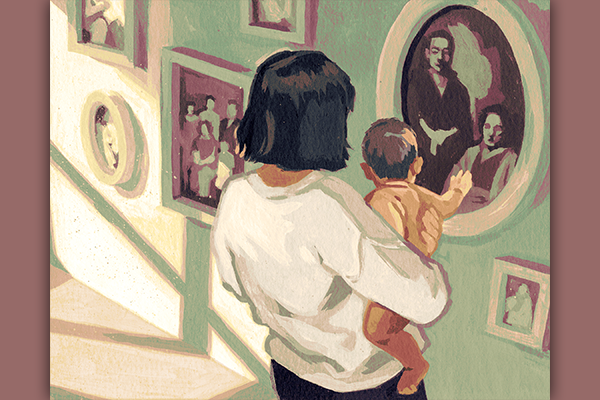“I did not know I had the power to leave.” — Jane
Jane told me as we walked towards her son’s school. A 40-year-old mother of three, she was trying to rebuild her life after finalizing her divorce process. I met Jane — whose name I’ve changed to protect her identity — two years ago at an empowerment group and have been walking alongside her as a survivor-advocate, learning from our shared and differing experiences as survivors.
At the time that we met, she was quiet, withdrawn, and constantly avoided eye contact. Noticing her unsettled demeanor, I reached out to her at the end of the group time to ask if she had the resources she needed. This simple gesture opened up a conversation that led me to learn her story.
For 10 years, Jane was married to a man she met at her church — a leader of the worship team. Everything seemed to be going well until she gave birth to her second child. The man Jane once knew as kind and loving turned into a violent stranger. She was scared to speak up because of her husband’s leadership position in the church. Afraid that no one would believe her, she assumed the role expected of her as a quiet, submissive wife. But when her husband threatened to hurt their children, Jane feared he would act on his threat; she reached out to the church for help. However, the leadership condemned divorce and encouraged her to “submit” in marriage. During this time, they allowed her husband to stay in his position of leadership.
Feeling betrayed, Jane sought support from other congregation members who heard her story and believed her. With their support, Jane left her abusive husband and moved to safe housing with her children. She is currently part of a domestic violence healing group, where we met, and no longer attends that church. Because the church’s leaders chose to believe her abuser, Jane no longer felt safe in a place that was supposed to be her sanctuary.
Jane’s story is one of many stories of survivors of domestic violence that I have had the opportunity to know over the years. According to the National Coalition Against Domestic Violence, 1 in 3 women and 1 in 4 men have experienced some form of physical violence by an intimate partner. In communities of faith, abuse often stems from toxic theology that asserts male power, dominance, and authority over women, though domestic violence happens to all people and all genders, in both heterosexual and LGBTQ relationships.
As a survivor myself, I resonate with the many fears and social constructs that forced Jane to stay in her abusive relationship. I also can relate to the experiences of betrayal that side with the falsified stories of men over the lived experiences of women. Communities of faith should be an intentional place for survivors of domestic violence to find healing, refuge, and safety. However, like in Jane’s story, it can also be an unsafe place that hinders the process of healing.
The steps, responses, and practices offered in this article are meant to be a beginner’s guide to what congregations — including lay members — need to know about preventing, recognizing, and responding to domestic abuse in their midst:
1. Recognize the Signs
Cultural stigma and fear of retaliation often prohibits women from speaking up against their abusers making it difficult to know that abuse is happening. For survivors to access adequate support, they need a loving, supportive community that will take notice when they are hiding in shame and oppressed by fear.
Some of the signs to recognize domestic violence are:
- Frequent injuries. Survivors may give excuses for their injuries by calling them “accidents,” blaming their own clumsiness.
- Visible marks. Survivors may have bruises on their arms, black eyes, busted lips, or sprained wrists.
- Clothing covering bruises. Survivors may dress in clothes that hide their bruises and wear long sleeves or scarves to hide evidence even when the weather is warm. They may wear sunglasses indoors to cover bruises on their face.
- Unsettled demeanor. Survivors may exhibit agitation and anxiety by flinching at loud noises, raising their arms in defense when someone moves toward them, or sitting in isolation.
- Depression. Survivors may show signs of depression and often have sudden loss of interest in activities that were once enjoyable. Abusers often dictate the survivor’s ability to make their own decisions and pursue what makes them happy.
- Deferring to the abuser. Survivors may defer to what the abuser wants or ask permission before making a decision. Abusers often control what survivors can and cannot do. Survivors may submit to the abuser’s authority for fear of retaliation at home.
- Isolation. Survivors may isolate themselves by cutting contact with family, friends, and other members of the faith community. If they were once especially active or outgoing, survivors may withdraw themselves from social gatherings.
2. Establish Safe, Not Perfect, Sanctuaries
Communities of faith tend to push the belief that their community is perfect. Because of this false belief, those experiencing domestic violence may not speak up for fear of being “imperfect” in the “perfect” space. The survivor may also fear judgment, especially if the abuser is a revered member of the faith community. When people speak out against perpetrators of sexual or domestic violence in the church, they are often met with disbelief. Abusers are also cunning shapeshifters who present themselves as perfect in public but are violent in private. The “perfect” public persona of the abuser is held in high esteem while their partner is shamed or blamed; women who are abused are often told by churches they need to submit to their husband’s authority.
But a “perfect” community does not make a safe community. In communities that encourage a perfection narrative, abuse has the potential to run rampant without policies in place to keep leaders accountable. To establish safety, communities of faith must develop systems of accountability that protect survivors, women, and other vulnerable people groups. If survivors feel safe, they may turn to faith leaders for support before seeking help from any other place. Therefore, faith leaders must know best practices to support the survivor, get them to safety, and provide essential referrals from within their local context.
- Believe the survivor’s story. Listen without judgment and validate their feelings.
- Support them in establishing safety. Support their decision to establish personal safety, whatever that looks like for them.
- Help with housing. Get them to safe housing at a location unknown to the abuser.
- Offer referals. Refer them to local domestic violence support agencies that provide legal aid and support groups.
- Fund their therapy. Help make it possible for survivors to recieve therapy with a trauma-informed counselor.
- Provide resources. Oftentimes, the abuser is the sole breadwinner of the family, controlling financial assets. Provide the survivor with holistic resources for the survivor and their family including schooling, child care, mental health resources, food, clothing, and safe shelter.
3. Implement a Culture of Care
To provide safety for survivors, faith leaders need to understand that domestic violence can happen in their congregation. A culture of care establishes safety for marginalized and vulnerable people in their community that may be prone to abuse based on their economic status, gender, or sexuality. Establishing safety and care requires intentional leadership that is trained on protection policies, understands trauma-informed care, and knows of local resources for referrals. Faith leaders must continue to educate themselves on the causes and effects of domestic violence to teach on it from a theological lens.
Scripture has also been used to condone and perpetuate violence, especially against women. A classic example is found in Ephesians 5:22-24: “Wives, be subject to your husbands as you are to the Lord. For the husband is the head of the wife just as Christ is the head of the church, the body of which he is the Savior. Just as the church is subject to Christ, so also wives ought to be, in everything, to their husbands.” This scripture is among many that has been manipulated by abusive husbands to assert power over women. Taken out of context, this passage can be used to instruct wives to remain in their marriages despite the violence and abuse they make be experiencing.
To counter the pervasiveness of toxic theology that subjugates people to abuse, communities of faith must own their unique responsibility to speak out against domestic abuse and empower those facing abusive partners to break the cycle of silence and violence.
- Preach. Preach on scriptures that have been used to perpetuate violence against women and re-interpret those passages to uplift the humanity and autonomy of all people.
- Support healthy relationships. Provide workshops on marriage and relationships from an egalitarian perspective.
- Train the congregation, including leaders. Talk about sexual and domestic violence in youth groups, small groups, and staff leadership meetings. Offer trainings for leadership on domestic violence prevention and response efforts.
- Connect with local resources. Provide accessible printouts, brochures, or web pages for congregation members to access local resources for survivors of domestic violence.
- Let survivors speak. Empower those suffering from abusive partners to speak up by providing platforms for them to lead and share their voice on topics that matter to them.
- Offer time and money. Assess ways to establish your faith community as a safe space and work actively to pursue justice for survivors. Volunteer at safe homes, engage in anti-violence efforts, and fund organizations that fight against domestic violence locally and abroad. Develop an emergency fund for survivors of sexual or domestic violence in your community.
- Name the sin. Publish a statement on your commitment to creating a culture of care by establishing policies that have no tolerance for abuse that takes place by church members.
Rather than condoning violence against women, communities of faith should be a pillar of safety and care for women, marginalized people groups, and survivors of domestic violence. To embody the justice and hope of Jesus, communities of faith must commit to being sanctuaries that bring healing and not harm. Our communities of faith have unique opportunities to choose safety over perfection, implementing cultures of care, and recognizing the harms of abuse by offering healing resources. If our communities of faith were truly safe, survivors like Jane would be able to find healing in the place they expect it to come from.
Survivors can thrive in safe spaces that unlearn the toxicity of patriarchal theology, prioritize the survivor’s holistic care, and establish policies that pursue accountability for its leaders and justice for the community. As survivors, we have been able to access healing through intentional love and consistent support from communities of faith. Let’s model Christ’s love by prioritizing survivors in communities of faith: protecting their bodies, believing their stories, funding opportunities for their healing, and creating a culture of communal care.
Nikole Lim also contributed to this article. She is a speaker, educator, author of Liberation Is Here, and founder of Freely in Hope.
Resouces from Sojourners:
- Take Action: Tell your senator to take action on the Equal Rights Amendment to ensure safety, justice, and equality for survivors of domestic violence.
- 100 Sermons: A collection of more than 100 sermons on sexual and domestic violence. sojo.net/100sermons
- Webinar: Learn how seminaries and other institutions can equip future faith leaders to address domestic and sexual violence. Watch the recorded webinar.
- Gender Justice Conversations: A monthly conversation of people of faith working to reduce and respond to domestic and sexual violence. Join here.
More resources:
Got something to say about what you're reading? We value your feedback!






